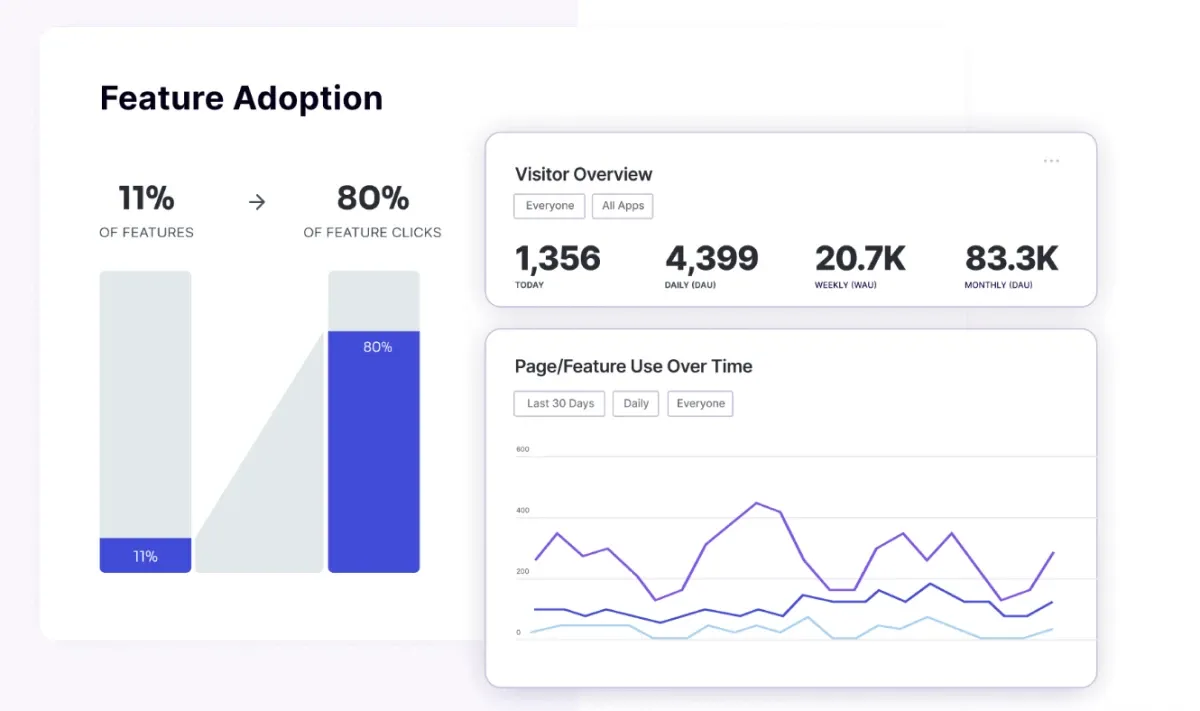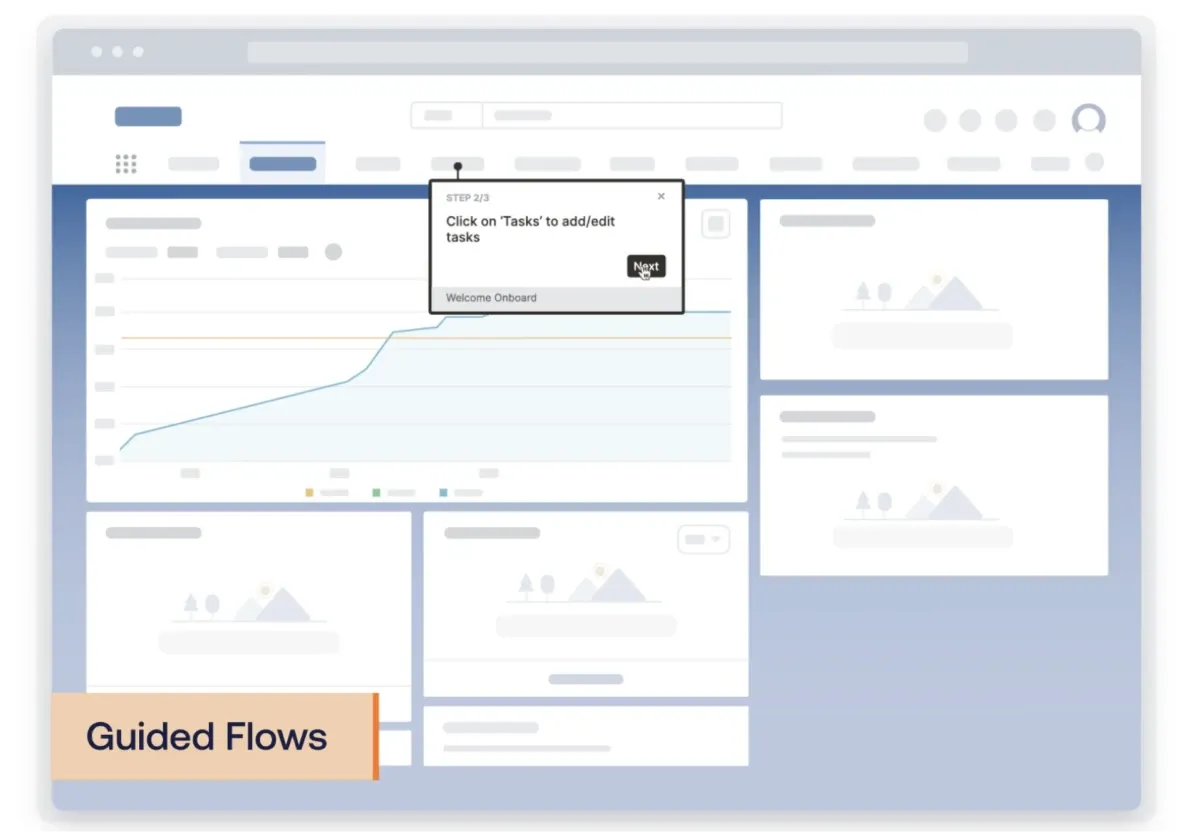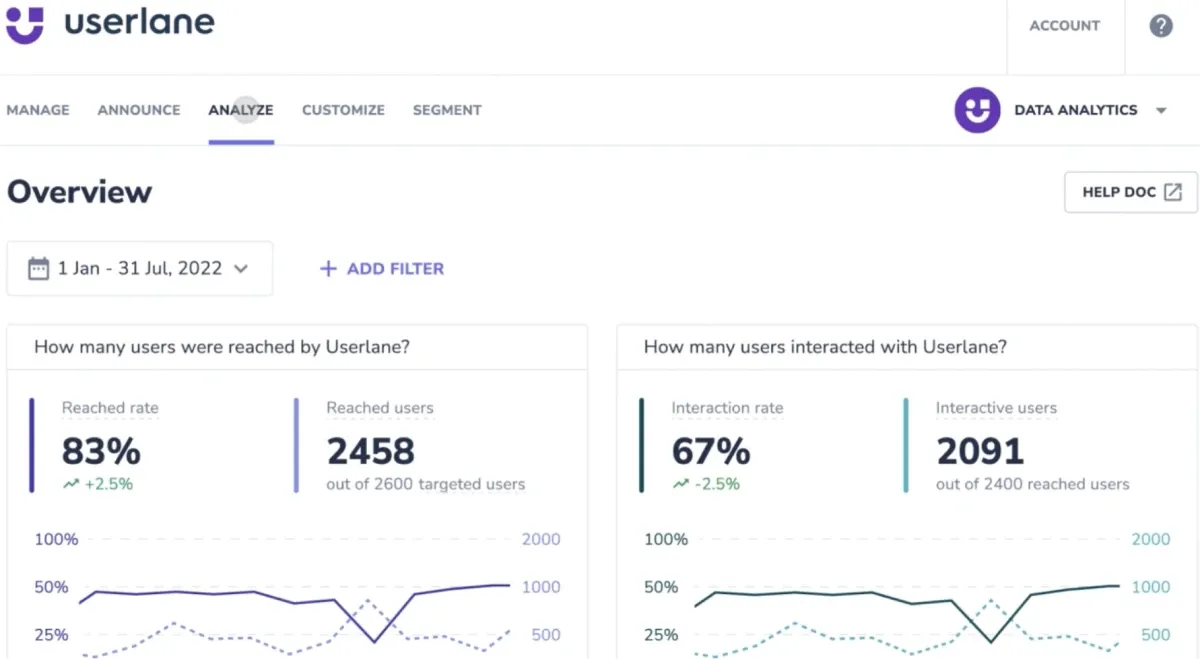What do product owners love even more than building a great SaaS product or mobile app? It’s hitting those product adoption numbers (and hopefully, even exceeding them!). Anyone who is closely involved in the product roadmap and development of a platform will tell you that a product is only as good as the users who adopt it. Digital adoption platforms (DAPs) help product managers and product marketers drive user adoption. One such platform is Appcues. While it stands out for its onboarding experiences and engagement features, it's important to recognize that it does come with several limitations, prompting you to consider alternatives.
- Steeper learning curve: Despite its no-code approach, Appcues can have a significant learning curve, especially when setting it up for the first time. This can be a hurdle for non-technical users who might end up needing extra support from the Appcues team.
- Cost scales with usage: Appcues' pricing scales with monthly active users (MAUs), which can become expensive for growing products. Some alternatives in the market offer more scalable pricing structures and may be a better fit for your budget.
- Customer support concerns: Some users have reported experiencing long wait times and additional fees for dedicated customer support with Appcues.
Key features to look for in an Appcues alternative
Here are some factors you can prioritize to identify a better alternative to Appcues.
- Ease of use and user experience: A user-friendly interface is a non-negotiable these days. Look for a platform with a drag-and-drop builder and clear navigation for creating and managing in-app experiences. The ideal platform should integrate seamlessly with your existing workflow.
- User onboarding customization: Look for a platform that allows you to personalize user onboarding experiences based on user attributes, behavior, and segmentation. This ensures users receive the most relevant guidance at the right time. This is important because your end-users want to feel appreciated and unless you give them a personalized onboarding experience, they’ll find your product too “generic” for their needs.
- Detailed analytics and reporting: Consider a platform that provides detailed analytics and reporting features. Also, A/B testing is a great feature to look for, as it allows you to compare different versions of your in-app experiences and identify the most effective ones. This way, your product’s experiences will be designed based not on gut instinct or someone’s creative notions, but on evidence.
- Scalable pricing: Choose a DAP with a pricing structure that scales with your growing user base.
- Customer support: Reliable and responsive customer support is essential for any software solution, so make sure that the DAP provider you end up choosing has rave reviews about their customer service.
Top alternatives to Appcues
Command AI – the non-annoying, AI-powered user assistance platform
Command AI is different. It is a digital adoption platform that offers truly non-annoying user assistance and empowers not just product, but marketing and customer experience teams as well.
Go beyond ordinary chatbots:
- Command AI’s Copilot isn't your average chatbot that answer basic queries. It's an embedded AI agent for actively training users using walkthroughs.
- You can use chat interactions to segment users, so that your “responses” are not generic, rather they fit the user’s context and support their specific needs.
Content delivery that’s actually relevant:
- Page targeting: Show users content that's relevant to the page they're on. No more irrelevant product tours shown randomly.
- Audience targeting: Customize content based on user actions or account tiers.
Product tours designed for different roles and needs:
- Audience segmentation: Not all users are created equal, so Command AI lets you get granular with your approach with their Product Tours where you segment who sees what, ensuring users get the most relevant introduction.
- Smart triggers: Command AI uses smart triggers to deliver targeted tours based on user behavior and sentiment. Depending on whether a user is frustrated or confused or simply returning to your app after a very long time, you can suggest “next action” or “resource” based on their state of mind.
Actionable checklists that drive user engagement:

- First-time walkthroughs: Onboard new users smoothly with guided walkthroughs.
- Promote new features: Interactive checklists that more like “quests” rather than “tasks”.
- Explore new use cases: Deepen user engagement by prompting users to explore different ways to use your product at different points in their journey.
Pendo
Pendo is a leading name in the world of digital adoption platforms. It goes way beyond what Appcues offers. Think in-app product tours, surveys, the whole shebang – but with an extra level of user insights that enterprises love. If you need to understand your users to a really granular level, Pendo might be the perfect fit for you.

Key features and benefits
- Solid view of analytics: Pendo has features like paths, funnels, and cohorts to show you exactly how users navigate your app. Imagine it as a GPS of your users, showing you exactly how everyone is moving along in your app and which parts of your app journey might need a tune-up.
- Actionable insights: Pendo tries its best to turn data into actionable insights that you can use to improve your platform or app. However, some limitations do exist, as in-app experiences cannot be triggered by user events (which frankly, can be a bit of a bummer).
- Drag-and-drop builder: Pendo runs a user-friendly builder with templates and a WYSIWYG (what-you-see-is-what-you-get) editor, so you can create your own in-app experiences – no coding required!
Pricing
Pendo has a free trial on offer if you just want to dip your toes in and see what the platform is all about. It’s got all the basics covered – for 500 monthly active users you can use analytics, in-app guides, NPS, surveys, and more. But if you want more advanced features like cross-app journey reports or capabilities, you’ll need to upgrade to a paid plan.
You can find out all the details about what each plan contains on Pendo’s website, but for the pricing details, you’ll need to chat with their sales team.
Pros
- Pendo provides powerful analytics for in-depth user behavior insights, perfect for enterprises that need microscopic-level detail.
- Pendo scales to meet the needs of large organizations that run more than one app.
- Pendo’s interface for creating and managing in-app experiences is known to be quite user-friendly.
- Users praise Pendo's responsive and helpful customer support team.
Cons
- Pendo's features can be overwhelming for new users or for smaller businesses that don’t have very sophisticated onboarding or user engagement needs.
- In-app experiences cannot be triggered by user events (actions within the app), which restricts the ability to deliver content based on user behavior.
- While Pendo offers customization, some features require CSS/HTML knowledge, making it challenging for users without technical skills to use.
- Pendo's reporting features have a bit of a learning curve, which can make them cumbersome for new users.
- Users have reported that Pendo's pricing structure might be cost-prohibitive for smaller businesses.
UserPilot
Userpilot is a digital adoption platform that is all about making the first impression – onboarding new users. It guides users towards that activation event, popularly known as the “aha moment” in SaaS businesses, where users realize the true value of your platform. It can also help existing users discover all the amazing features contextually, that is, based on what they are doing in the app at a particular time.

Key features and benefits
- Targeted user onboarding: Userpilot doesn't treat all users in the same way. It personalizes the onboarding experience based on who the users are and how they behave within the app.
- Detailed user segmentation: Userpilot lets you segment your users, which means you can create experiences within your platform or app that are ultra-relevant to a specific group of users instead of being generic experiences rolled out to one and all.
- Code-free interface: A user-friendly, no-code interface is a boon for anyone tasked with designing onboarding experiences but doesn’t have coding expertise.
Pricing
Userpilot has a “Starter” plan that starts at $249 a month, but it's limited to 2,000 active users each month. This might be perfect for a smaller team just getting started. They also have a "Growth" plan for $749 a month that unlocks more features. Then there's the Enterprise plan for which you'll need to contact their sales team for a custom quote. A heads up – like every other digital adoption platform, some of the advanced analytics, targeting options, and top-grade security features are only available on the higher-priced plans.
Pros
- Having user segmentation capability means that you can make sure that your message reaches the right users at the right time.
- A no-code, user-friendly interface means that anyone who has the right, can create an in-app experience with zero technical knowledge.
- Userpilot has a reputation for providing stellar customer service, so even if you do get stuck somewhere, there’s always a helpful “somebody” around.
Cons
- Since Userpilot has a strong focus on user onboarding, if you need a broader DAP that tackles other aspects of product adoption as well, Userpilot might not be the best platform for you.
Whatfix
Whatfix stands out as a leading digital adoption platform that caters to a much wider range of use cases as compared to Appcues. While Appcues focuses on customer-facing applications, Whatfix works for both customer-facing as well as internal employee applications. This means Whatfix can work on user adoption across your entire digital ecosystem, and not just one part of it. What’s more, Whatfix goes beyond web applications by offering solutions for desktop and mobile environments. Your audience can get a consistent experience from your products and apps, regardless of device.

Key features and benefits
- Wide range of use cases: Whatfix caters to diverse needs and can help businesses set up experiences for everything ranging from user onboarding to employee onboarding to digital transformation.
- Detailed product analytics: Identify critical user behaviors, track user feedback, and get your finger on the pulse of user sentiment to identify areas for improvement in your app.
- In-app guides: Creating in-app guides and content without coding means it is easy to whip up help resources and product walkthroughs.
- In-app messaging: Broadcast announcements, surveys, and updates can be put up directly within the app, so you can keep communicating with your users in a timely manner.
Pricing
Whatfix has separate plans for web & desktop, and mobile apps. While specific pricing details are not publicly available, you can easily compare the feature sets of each plan to get a good idea of what's included in each tier.
Pros
- Whatfix supports a wider range of use cases compared to Appcues so with a single investment you can get more bang for your buck.
- Users praise Whatfix's strong customer support.
- Whatfix has helped companies tackle new user onboarding challenges. Having everything organized in one central location is also a game-changer, according to some happy customers.
Cons
- Unlike some competitors, Whatfix doesn't publicly reveal their pricing details which can make it tricky to compare costs upfront and see how it fits your budget.
Userlane
Userlane is a digital adoption platform best suited to improve user experience for complex software applications. Where it stands apart from others in the DAP space is by providing real-time, in-app guidance to users. Since support is offered directly within the app on demand, it eliminates the need to consult support resources separately.

Key features and benefits
- Real-time analytics: See how your users are interacting with your software and identify areas for improvement.
- Effortless guide creation: Create, update, and manage clear and helpful guides in seconds, with no coding skills required.
- Context-sensitive help: Userlane offers smart contextual help so users’ questions can be answered whenever they ask them. Plus, Userlane can display announcements and pop-ups with helpful content based on what they are working on in the app at a given time.
Pricing
Userlane takes a custom approach to pricing based on a company’s specific need, so you'll need to contact their sales team for a customized quote.
Pros
- Userlane fast-tracks your users’ introduction to the product as it streamlines the onboarding experience as well as provides businesses with insights into user behavior so you can identify gaps and optimize the user journey at all points.
- Since user guides and walkthroughs can be baked into the product itself, it reduces product-related support tickets, freeing up your customer service team to handle more complex issues.
- Userlane acknowledges that different users have different needs, so they have built features that allow you to tailor onboarding journeys for various user segments. This way users receive guidance on the most relevant tasks and processes for their specific roles.
Cons
- While Userlane excels at in-app walkthroughs and tutorials, it might not be as comprehensive in other areas of user adoption or user engagement, such as email drip campaigns.
- Userlane doesn't display its pricing tiers upfront, which can be inconvenient for those doing initial research to compare products.
Exploring alternatives to Appcues
Product adoption is at the core of a product’s success. If you miss out on giving your users the right guidance at the right time, you risk failing to achieve your product goals and hindering customer retention.
Digital adoption platforms bring the best of technology to bridge the gap between what your product offers and a user’s understanding and appreciation of it. While Appcues is a well-known player in the DAP market, it's important to compare features across different players. This will help you identify the solution that best aligns with your unique priorities, user adoption goals, and of course, your budget.
Need something for a large organization? Pendo might be a good fit as it is designed to handle the demands of complex user adoption challenges within large organizations.
Want something dedicated to user onboarding? Look to UserPilot. They specialize in helping you create onboarding experiences so your users get up and running quickly.
Targeting user adoption for both customer-facing and internal applications? Whatfix might be your solution. They offer a comprehensive suite of user adoption tools that makes them a good choice for both internal and external use cases.
Want context-sensitive help for complex software applications? Consider Userlane. They excel at providing in-app help that adapts to user needs based on their current actions and context within the software.
Need a completely non-annoying user assistance platform that works seamlessly within every user's context? Command AI is your answer (in fact, it’s the perfect answer). They prioritize a user-friendly approach, so you can offer non-intrusive help that integrates directly into your user's workflow.
The bottom line? Choosing the right digital adoption platform is all about making your users happy without breaking the bank. With a DAP in your tech ecosystem, you can see a boost in user adoption, which means a more successful product and ultimately, business numbers that trend upwards.

















